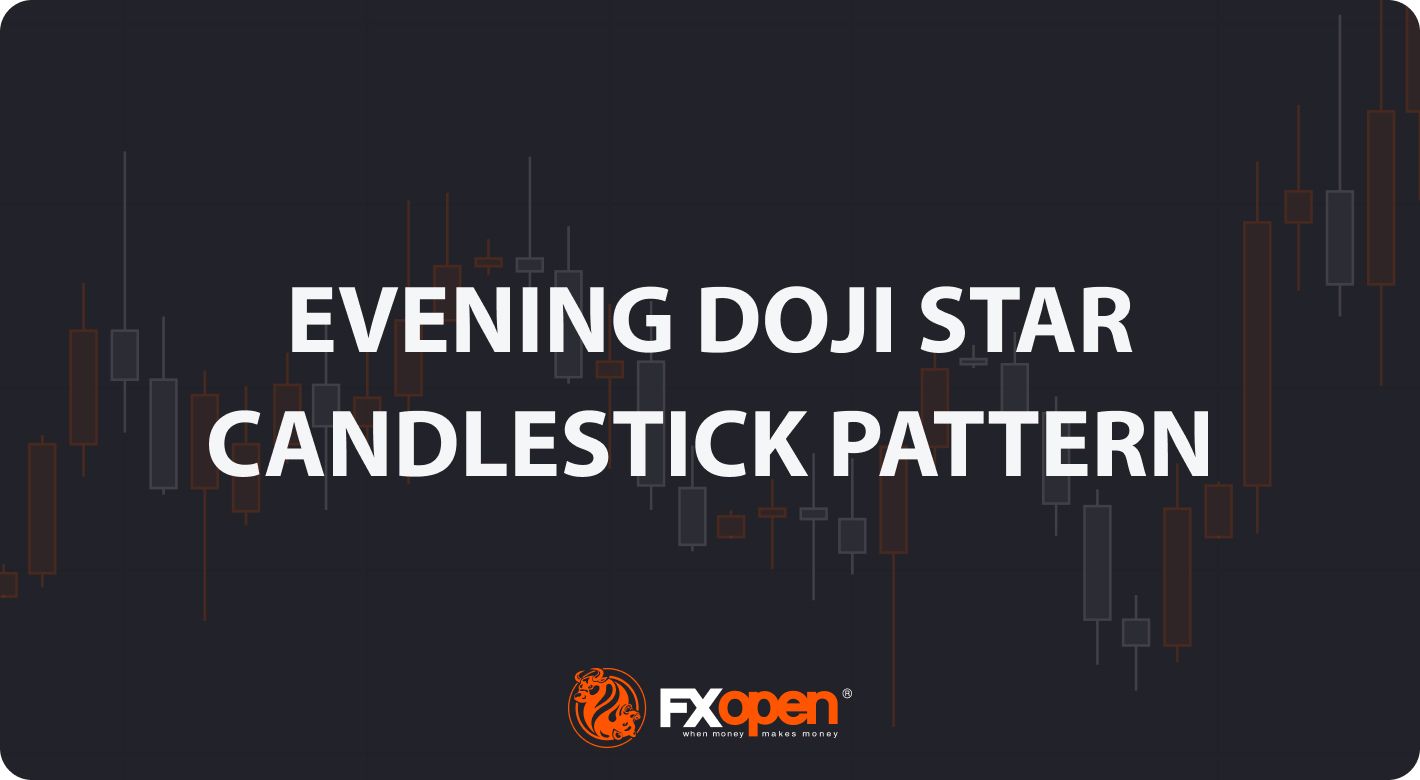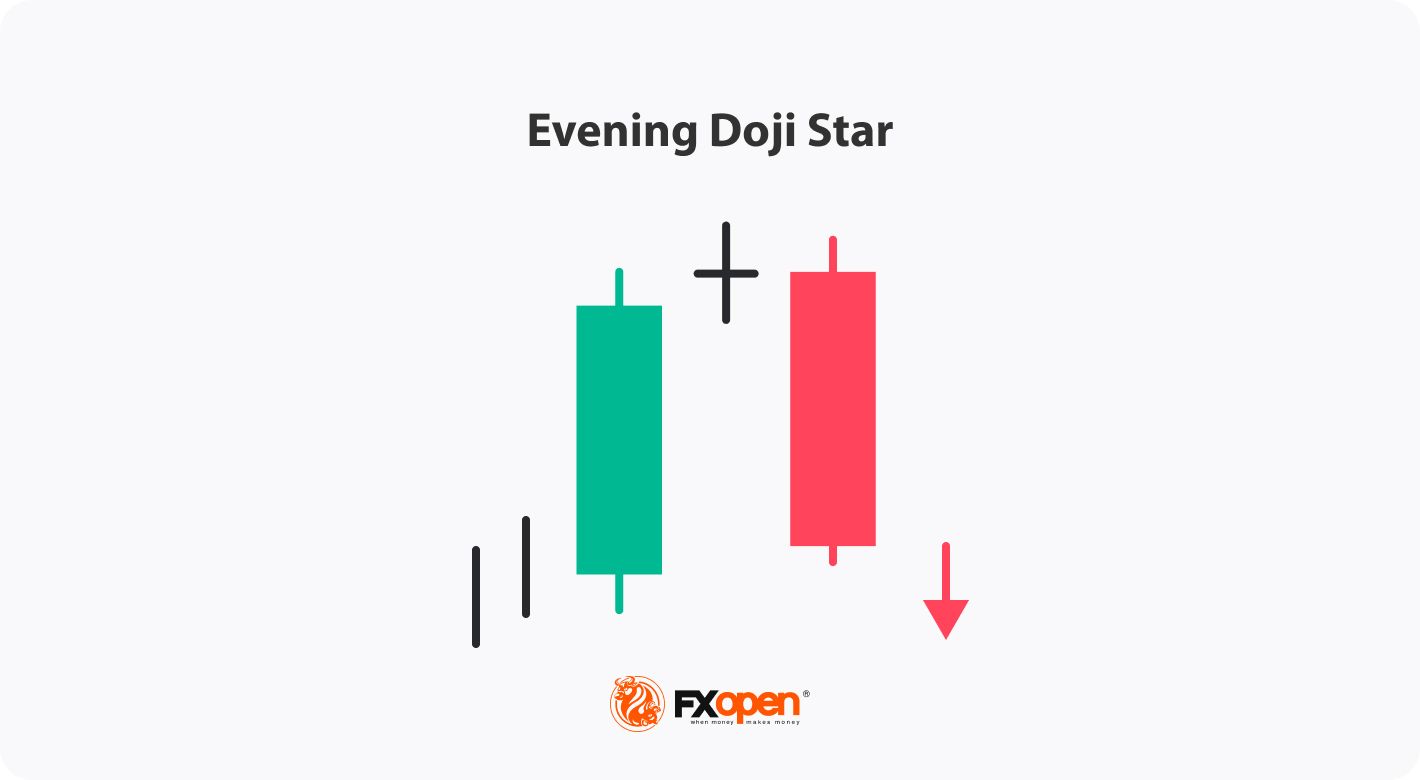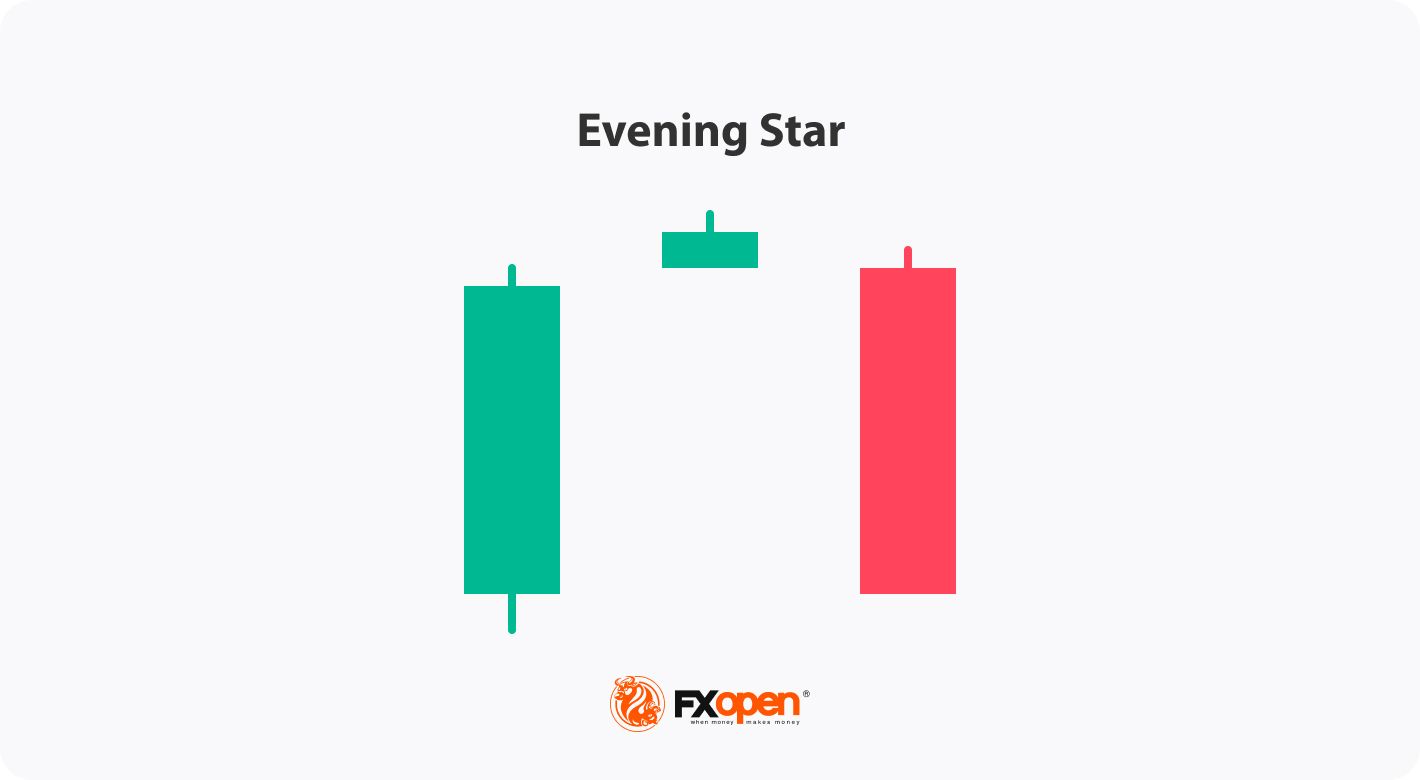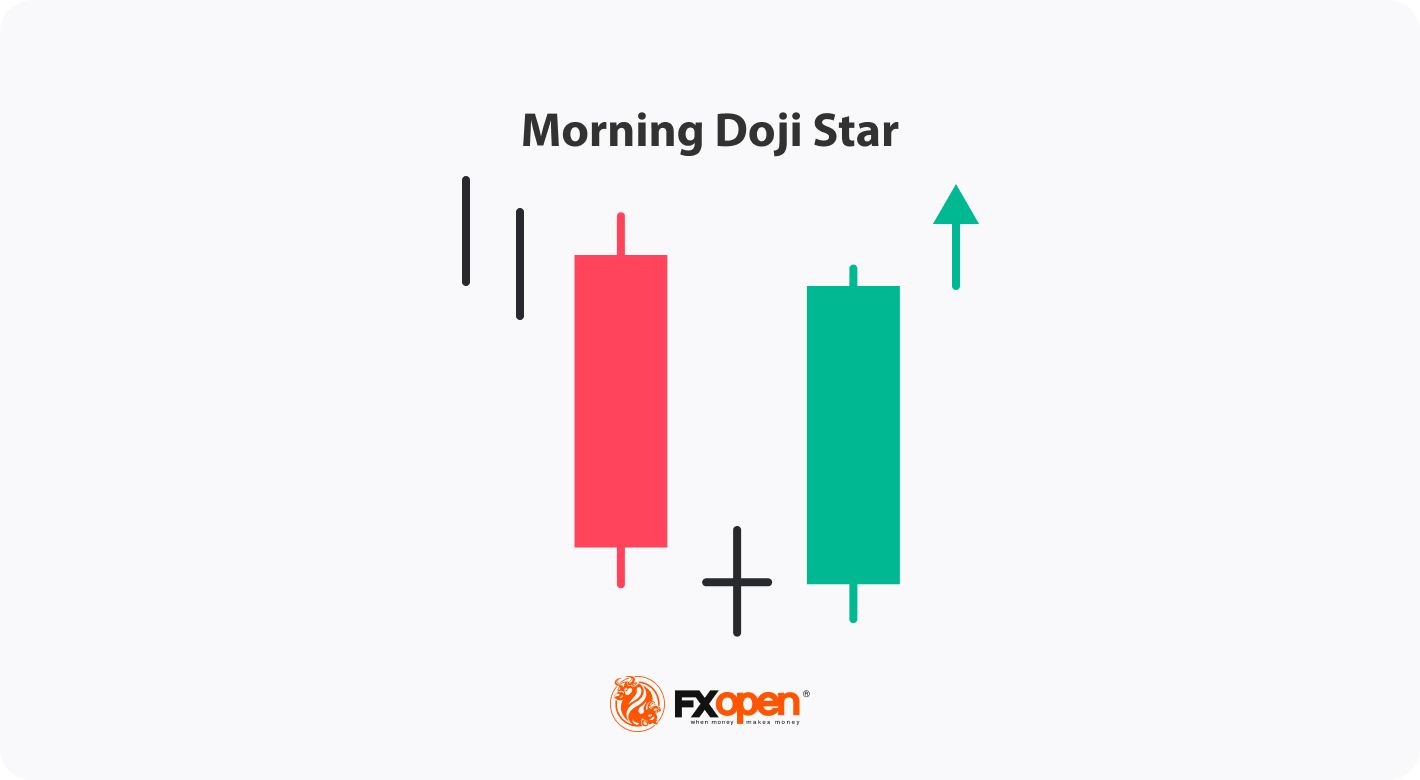FXOpen

The evening doji star is a widely used pattern in price action analysis, which traders and technical analysts often employ to spot possible trading opportunities. This setup signals a potential trend reversal from an uptrend to a downtrend and can be a useful tool for market participants to have in their arsenal. In this article, we will delve into the technical aspects of the evening doji star, exploring how to spot it on a chart and trade it effectively.
What Is the Evening Doji Star Candlestick Pattern?
The bearish evening doji star candlestick pattern is a technical analysis tool that signals a potential reversal at the end of an uptrend. This formation is characterised by three candlesticks, with the second being a doji.
Keep an eye out for the following to identify it on a price chart:
- Uptrend: The market should be in a solid uptrend, and the first candle should be long and bullish.
- Indecision: The second candlestick in the formation should be a doji, indicating indecision in the market. It may have either no body or a small body, but it is essential that the opening and closing prices are relatively close to each other. If it opens with a gap up, the formation will be considered more reliable.
- Downtrend: The third candlestick should be strong and bearish and close below the midpoint of the first bullish candle. If it forms with a gap down, the sell signal is considered stronger. Also, if it closes below the low of the doji, it further strengthens the sell signal.

While identifying the evening doji star candlestick pattern may require some chart analysis skills and experience, it can be a valuable tool for market participants. This setup can be traded across various financial instruments, including stocks, commodities, cryptocurrencies*, and forex.
At FXOpen, traders can trade a diverse range of financial instruments, including forex, stock, index, ETF, cryptocurrency*, and commodity CFDs.
Evening Doji Star and Other Patterns
Traders must be careful not to confuse the evening doji star candle pattern with other candlestick formations, such as the morning star. While the latter indicates a potential trend reversal from a bearish to a bullish trend, the former suggests a potential reversal from an up to a downtrend.
Another formation you may confuse with the evening doji star is the evening star. It is essential to identify the correct structure to make informed trading decisions.
Evening Star
The evening and the evening doji stars are two distinct candlestick formations traders use in technical analysis to identify potential trend reversals.
The evening star structure can be characterised by the following:
- A long bullish candle that signals a strong uptrend
- A small-bodied candlestick, which could be either rising or falling and signifies indecision in the market
- A long bearish bar that confirms a reversal of the uptrend.
The evening doji star is a variation of the evening star, which signals more significant indecision in the market and can be a sign of a more potent trend reversal.

Morning Doji Star
The morning and evening doji stars both have a small-bodied candle in the centre, but their differences lie in their trend direction and candlestick shape. The morning setup suggests a possible change from a downtrend to an uptrend, while the evening formation implies a potential shift from an uptrend to a downtrend. The morning setup has a long falling candle, followed by a doji, and a long rising candle, while the evening pattern has a long rising candle, followed by a doji and a long falling candle.

Before risking capital in live trading, traders can analyse the morning and evening setups for free using the FXOpen TickTrader platform. This allows market participants to familiarise themselves with the patterns and assess their effectiveness in a risk-free environment before making any real trades.
Evening Doji Star Candlestick Pattern: Trading Scenario
Traders can use the following steps:
- Identify the setup: Look for a setup on the chart formed after a solid uptrend.
- Confirmation: After identifying the formation, traders should confirm the signal before entering a short position. One way to confirm it is to look for a falling candle to follow the setup. You may also consider using technical indicators such as the relative strength index (RSI) and its overbought/oversold signals or moving average crossover to confirm the reversal.
- Enter a short position: You can consider entering a short position once the setup is confirmed. Traders usually place a stop-loss order above the highest point of the formation to manage risks.
- Determine a take-profit target: The theory states that traders can close their positions at the closest support area or demand zone. Also, market participants sometimes look at higher timeframes and close the trade when the price goes near the significant support levels there.
- Monitor the trade: Traders continuously monitor the trade and adjust the stop-loss and take-profit levels as needed based on market conditions.

The setup on the M1 chart of EURUSD. The 1, 2, and 3 points show the bullish, doji, and bearish candles.
Final Thoughts
Although candlestick patterns like the evening doji star can be useful for traders to spot potential trend reversals, traders should not rely solely on them when making trading decisions. It's important to incorporate technical indicators and risk management strategies to mitigate potential losses. It's also essential to be aware of false signals and adjust trading strategies accordingly. Once you feel ready to implement these strategies, you can open an FXOpen account.
FAQ
What is an evening doji star?
It is a bearish reversal candlestick formation that appears at the end of an uptrend. It consists of three candles:
- A long bullish, indicating a strong uptrend
- A doji candle with a small or no body, indicating indecision in the market
- A long falling one, confirming the reversal of the uptrend.
The price action suggests that the bulls are losing their control over the market, and the bears may take over soon.
Is the evening star bullish or bearish?
The evening star is a bearish setup, indicating a potential reversal of an uptrend. It consists of a long bullish candle, followed by a small-bodied candle (which could be rising or falling) that indicates market indecision, and then a long falling candle that confirms the reversal of the uptrend.
How do you trade the evening star?
Traders usually enter a short position once the signal is confirmed with a technical indicator or price action. Traders usually place a stop-loss order above the highest point of the star to manage risks and close the trade when the price reaches the nearest support level.
What does a doji star mean?
It is a candlestick pattern that appears on a chart and signals indecision in the market. It occurs when the open and close prices of the second candle are nearly the same, but the upper and lower shadows are long. The setup can be found in both bullish and bearish trends and can indicate that either bears or bulls, respectively, will take control of the market.
*At FXOpen UK and FXOpen AU, Cryptocurrency CFDs are only available for trading by those clients categorised as Professional clients under FCA Rules and Professional clients under ASIC Rules, respectively. They are not available for trading by Retail clients.
This article represents the opinion of the Companies operating under the FXOpen brand only. It is not to be construed as an offer, solicitation, or recommendation with respect to products and services provided by the Companies operating under the FXOpen brand, nor is it to be considered financial advice.
Stay ahead of the market!
Subscribe now to our mailing list and receive the latest market news and insights delivered directly to your inbox.








